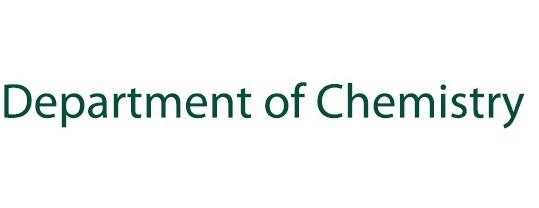welcome to our lab!

Instrumentation Available in Our Lab
| Our Synthetic Labs are located in
rooms 428 and 429 in the Chemistry Building. In these rooms we have: |
||
| Dry
Boxes:
We maintain two inert atmosphere boxes: a double-box for synthesis as
well as a second single dry box devoted primarily to the preparation of
samples for steady-state and time-resolved optical measurements as well
as electro/spectroelectrochemical measurements; this second box houses
a fiber-optic based spectrophotometer (Ocean Optics) and a CH Instruments Model CHI620D electrochemical workstation. |
||
| Fume Hoods: Our lab has ten fume
hoods in total, nine of which are used for synthetic work and are
outfitted with Schlenk lines. The last one is a large hood which houses the oven for making solar cells. |
||
| Varian Cary 50 UV-Vis-NIR spectrophotometer. |
||
| Our Instrument Lab is in room 418. Here you can find: |
||
| Perkin-Elmer Lambda 1050 UV-VIS-NIR spectrophotometer (190 – 3300 nm). |
||
| Horiba Jobin-Yvon Fluorolog 2 fluorimeter
with multiple gratings, photomultiplier tubes, cooled housings, etc. to
enable detection down to ca. 1000 nm and radiative quantum yields of
< 10-3. |
||
| A home-built
set-up for the measurement of current-voltage and incident
photon-to-current efficiency (IPCE) curves for photovoltaic cells
consisting of a Xenon 450 W ozone-free lamp and housing (Horiba
Jobin-Yvon), a motorized MicroHR Imaging Spectrometer with a switchable
turret for a grating (600 g/mm, 500 nm blaze) and mirror, a CH
Instruments Model CHI620D potentiostat, an Ophir-Spiricon Nova II power
meter supply with 3A-SH detector, and associated filters for AM0 and
AM1.5 solar spectrum simulation. |
||
| Our Nanosecond Laser Lab is in room 420. We have two laser systems here: |
||
| Nanosecond Time-Resolved Absorption and Emission Spectrometer OPOTEK Vibrant 355 II Nd:YAG-pumped optical parametric oscillator with UV extended capabilities, providing tunable wavelength output from 300 – 2400 nm (10 Hz, 5 ns pulse duration, 5 – 25 mJ/pulse, nominal). This is used for both time-resolved absorption and time-resolved emission measurements. |
||
| Time-resolved Emission:
using a MacPherson Model 272 f/2 monochromater and R928 PMT coupled to
a LeCroy Model 9360 300 MHz digitizing oscilloscope for monitoring
emission in the 400 – 800 nm range. A second grating is also available,
along with a thermoelectric cooled InGaAs detector, to acquire emission
in the NIR. The temporal resolution of the experiment is ca. 10 ns. |
||
| Time-resolved Absorption: Excited-state
absorption measurements using the output of the OPO focused through a
cylindrical lens onto the sample and a probe beam consisting of a
current-intensified 150W Xe arc lamp with special beam-shaping optics
to homogenize the output (Applied Photophysics) and a MacPherson Model
2035 monochromater outfitted with an R446 PMT (contained in a specially
wired housing to compensate for the high photo flux of the probe); an
avalanche photodiode is also available to enable ns experiments at
probe wavelengths up to 1 μm.
Output from either detector can be coupled to the LeCroy scope. The
data (corrected for baseline as well as sample emission) are worked up
using locally written programs. The temporal resolution of the
experiment is ca. 10 ns. |
||
| Nanosecond Time-Resolved Step-Scan Infrared Absorption Spectrometer OPOTEK Vibrant 355 II Nd:YAG-pumped optical parametric oscillator, providing tunable wavelength output from 400 – 2400 nm (10 Hz, 5 ns pulse duration, 5 – 25 mJ/pulse, nominal). A step scan-modified Bruker IFS66 FT-IR Spectrometer with a standard glowbar source (N2-purged). Typical data acquisition protocol involves the use of an AC/DC-coupled photovoltaic Kolmar Technologies mercury cadmium telluride (MCT-PV) detector with a 20 MHz preamplifier.Two additional detectors are also available: (1) InGaAs (12,000 – 5,000 cm-1 resolution); and (2) MCT (2,000 – 400 cm-1 with ~20 μs resolution). |
||
| Our Femtosecond Laser Lab is located in room 53. | ||
| Long-pulse system (“Wile E”) • Ti:Sapphire oscillator
(Coherent Mira 900) operating at 803 nm pumped by a Coherent 5 W Verdi
V-5 diode-pumped Nd:YVO4 at 532 nm, producing ca. 10 nJ of ~100 fs (13
nm FWHM) pulses at a repetition rate of 76 MHz.
• 1 kHz Ti:Sapphire regenerative amplifier (Positive Light Spitfire, pumped by a Coherent Evolution 15 Nd:YLF laser at 527 nm) yielding 1 mJ pulses at 800 nm, FWHM ~100 fs). • two optical parametric amplifiers (Quantronix TOPAS). One OPA is fitted with crystals to provide continuous tunability from 0.290 – 2.5 μm at energies in the range of 3 - 100 μJ/pulse, depending on the wavelength. The second OPA has an expanded range covering 0.240 – 11 μm; the pulse widths from both OPAs are nominally 100 fs FWHM. • probe beam generated via self-phase modulation in CaF2 or sapphire (320 – 900 nm and 400 – 800 nm, respectively) using residual 800 nm light from the regen. Detection is achieved using 10 nm bandpass filters and matched photodiodes coupled to a lock-in amplifier for single-wavelength kinetic traces, or by focusing the continuum into a liquid light guide coupled to a SPEX 270M spectrograph/1024-element detector (Hamamatsu HC233-0900 with a NMOS C-9564 array) for the acquisition of full spectra in the visible. Single-wavelength data at wavelengths beyond the range encompassed by the continuum are available from the second OPA. Data are manipulated using LabView with software modules of local design. • A 1.035 m delay line (linear actuator, LMAC series, Aerotech), providing a dynamic range of 13.3 ns. This temporally overlaps with the nanosecond instrumentation and resolves a significant temporal blind spot in our previous experimental protocol. The availability of the short-pulse system described below furthermore allowed for optimization of the Wile E instrument to longer timescale (i.e., >10 ps) kinetic processes. |
||
| Short-pulse system (“Road Runner”) • Coherent Mantis
model-locked Ti:Sapphire oscillator (80 MHz, 805 nm, >70 nm FWHM,
OPSL pump) seeding a Coherent Legend Elite USP Ti:Sapphire regenerative
amplifier (pumped by a Coherent Evolution 15 Nd:YLF laser, 527 nm, 1
kHz), producing a 1 kHz train of pulses centered at 800 nm (30 nm FWHM,
1.4 W).
• Regen output is split 70:30 and used to pump two Coherent OPerA SOLO optical parametric amplifiers (tuning range of 290 – 2600 nm each) with OPA 1 acting as the pump source and OPA 2 as a single wavelength probe as needed; pulse compression out of the OPA affords temporal resolution of <50 fs. • Aerotech ATS-100 delay line with a dynamic range of 1.4 ns at a resolution of <10 fs. • Probe beam via continuum generation in CaF2 and/or sapphire, as well as other protocols for the measurement of transient absorption data similar to that described for the Wile E system above. |
||
Click here for pictures of the ultrafast laser lab.
 |
 |